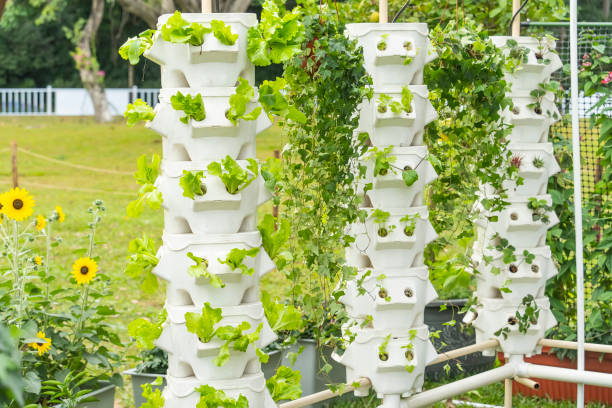Understanding the Science of Aeroponic Tower Gardens
Aeroponic tower gardens are a fascinating leap forward in agricultural technology, based on the principle of growing plants with their roots suspended in air and misted regularly with nutrient solutions. This contrasts with traditional hydroponic towers, where roots are submerged in water.
The aeroponic method delivers nutrients directly to plant roots via fine sprays, ensuring roots receive both oxygen and nutrition in an optimized balance. This system creates ideal conditions for rapid plant growth and healthier root systems.
Comparing Aeroponic Tower Gardens to Other Hydroponic Towers
Hydroponic towers come in many forms: nutrient film technique (NFT), deep water culture (DWC), and ebb and flow systems. Aeroponics differs by exposing roots to air rather than continuously submerging them. This exposure significantly increases oxygen intake, which promotes faster cell development.
Key Differences Include:
- Root Environment: Aeroponics suspends roots in air; other hydroponic towers submerge roots in water.
- Water Usage: Aeroponics uses less water by recycling nutrients efficiently.
- Growth Rate: Aeroponics can triple the speed of plant growth compared to soil and significantly outpace some hydroponic systems.
How Aeroponic Towers Achieve Such Efficient Growth
The root chamber of an aeroponic tower is designed to keep roots open to oxygen while misting them with nutrient-rich water every few minutes. This cycle ensures roots never dry out but also never drown, which can happen in submerged systems. The result is a vigorous root system capable of supporting rapid shoot growth above ground.
Advantages of Aeroponic Tower Gardens for Home Growers
- Space Efficiency: Vertical design allows multiple plants to grow in the footprint of a few square feet.
- Water Conservation: Closed-loop watering means minimal waste.
- No Soil Needed: Reduces mess and eliminates soil-borne diseases.
- Controlled Nutrition: Easily adjust nutrient profiles to match plant needs.
Best Plants for Aeroponic Tower Gardens and Hydroponic Towers
Leafy greens like lettuce, arugula, and spinach thrive best in aeroponic towers. Herbs such as mint, cilantro, and basil also do well. For fruiting plants such as cherry tomatoes or strawberries, additional support structures are recommended.
Why Aeroponic Tower Gardens Outperform Traditional Hydroponic Towers
- Root Health: Aeroponic towers reduce the risk of root rot since roots are never waterlogged.
- Growth Speed: Studies show aeroponic plants can grow up to three times faster than soil-grown plants and significantly faster than many hydroponic methods.
- Water and Nutrient Efficiency: Closed-loop designs recycle water and nutrients, making aeroponic towers highly sustainable.
Setting Up an Aeroponic Tower Garden at Home
Installation involves assembling the tower, filling the reservoir with water and nutrients, and setting timers for misting intervals. For indoor use, supplemental LED grow lights may be necessary to simulate sunlight, especially during shorter days or low-light conditions.
What You Can Grow in Aeroponic and Hydroponic Towers
Leafy greens and herbs are the easiest and most productive crops. However, with proper supports, fruiting vegetables and even strawberries can be grown successfully. The compact footprint allows urban gardeners to produce more food per square foot than traditional methods.
Addressing Common Challenges in Aeroponic and Hydroponic Tower Gardens
Keeping the nutrient solution clean and monitoring pH levels prevents plant stress. Pumps and timers must be maintained to ensure continuous nutrient delivery. However, modern aeroponic towers are designed to be user-friendly and low maintenance.
Maintenance Tips for Aeroponic Towers
Maintaining proper pH (5.5-6.5) and checking nutrient levels regularly ensures optimal plant health. Using timers for watering and grow lights creates a consistent environment for indoor farming.
How Does an Aeroponic Tower Garden Work?
An aeroponic tower garden consists of several vertical modules stacked to create a tall, compact garden. At the base is a reservoir holding a nutrient solution that is pumped to the top of the tower. The solution then drips or mists down over the suspended roots, providing nutrients and hydration.
This cyclical process continues automatically on a timer, ensuring roots receive regular intervals of moisture and oxygen. The design enables plants to thrive in a controlled environment without soil, pests, or diseases common in conventional gardens.
Conclusion: ALTO Garden—Your Partner in Aeroponic and Hydroponic Tower Gardening Success
ALTO Garden’s innovative aeroponic tower garden make it simple to experience the advantages of this advanced gardening method. Whether you are growing indoors or outdoors, ALTO Garden provides durable, easy-to-use hydroponic towers that maximize yields while conserving resources. Explore the benefits of aeroponic tower gardening and join a sustainable revolution in food growing.
- Aeroponic Tower & Aeroponic Garden Towers | ALTO Garden
- In an aeroponic tower, plant roots are suspended in air for higher oxygen uptake. Aeroponic tower gardens also recycle nutrients for higher efficiency.
- Aeroponic Garden Towers
Related posts:
 Smilo helps Barnsley patients enjoy long-lasting healthy smiles
Smilo helps Barnsley patients enjoy long-lasting healthy smiles
 Your Skin’s Best Life: Building a Routine That Heals and Protects
Your Skin’s Best Life: Building a Routine That Heals and Protects
 Is Laser Liposuction Painful or Comfortable? Comprehensive Guide
Is Laser Liposuction Painful or Comfortable? Comprehensive Guide
 Nasha Mukti Kendra in Saket Are Using This Secret to Save Their Teens from Drugs
Nasha Mukti Kendra in Saket Are Using This Secret to Save Their Teens from Drugs
 Scalp Conditions and Hair Thinning? How Trichology Can Help Restore Your Hair
Scalp Conditions and Hair Thinning? How Trichology Can Help Restore Your Hair
 Is It Safe to Buy Generic Sifasi HCG Injections Online? Benefits, Risks & Smart Buying Tips
Is It Safe to Buy Generic Sifasi HCG Injections Online? Benefits, Risks & Smart Buying Tips
 The Common Parasitic Infections and Their Effective Treatments
The Common Parasitic Infections and Their Effective Treatments
 Explore Your Guide to Buying Prohormone Supplements for Sale Online
Explore Your Guide to Buying Prohormone Supplements for Sale Online








